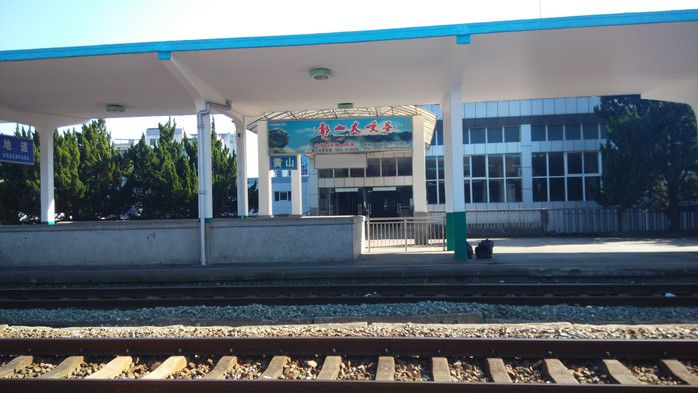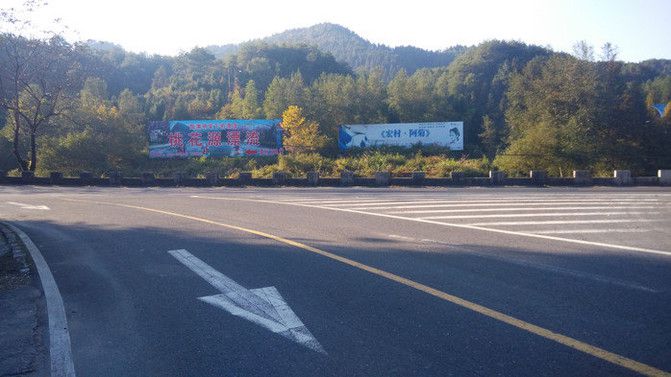
Budget: 2500 yuan.
Liu Ziping and I were busy with our work, and we didn't have much money. Our appointment was to travel far away once a year. But after I graduated, I went to Zhouzhuang in the first year. After that, my plans for the next two years were all stranded because of all kinds of trivialities. This year, those who didn't give up made an appointment again and finally made it. Looking back on the great mountains and rivers of the motherland, it's still very pleasant.

Attached is a strategy we did at that time. It's quite a sense of achievement. Ha ha.
Day4 October 20 Hongcun Huangshan Scenic Area Huangshan Baiyun Hotel
On October 22, we: Huangshan - Nanjing; Daliuzi: Nanjing Lianyungang
Kanhua inn is an inn located in the center of Xidi ancient town. The landlady is very enthusiastic and meets us at the entrance of Xidi. Our reservation is a big bed room, the room facilities are pretty good, very clean. Gossip about it, I heard that her family has 11 rooms, so I envy the days of the charterer!
This trip is said to start on October 17. In fact, only daliuzi left today. Today is Saturday, but the hard-working Da Liuzi is still working overtime. After leaving the train, he goes straight to the railway station and takes the k8358 train from Lianyungang east to Shanghai to Nanjing to join me.
Nanjing
Because there were few people on the bus, the journey to Huangshan was relatively long, nearly nine hours. At the beginning, we chatted happily about various topics. Later, after chatting for several hours, I was a little tired. They began to enjoy the scenery outside the car window and take photos.


After leaving the station, according to the owner of Xidi Inn, I wanted to take a taxi to Huangshan bus station, but as soon as I got out of the station, there were people pulling drivers outside. A driver told us that their bus is to Xidi, absolutely no problem. I got on the bus with big Liuzi. In fact, I was a little nervous. Big Liuzi said that the bus had a Xidi written on it. It must have arrived. I didn't insist on changing. After departure, I asked the conductor. The conductor said that this bus was for Yi County, but it could stop on the road at the entrance of Xidi, where I could take a bus to Xidi. At that time, I knew I had taken the wrong bus.

Ordinary people in the alley
--------------------------------2015-10-19--------------------------------------
To the back stream.
We met a family with very thick plants on the wall, so we stopped and patted~
Think of the lyrics, half full of sea water, half full of fire...
On the right is the village stream.
Abandoned flatbed truck on the side of the road.
It's the corner of CYTS.
Every time I sigh, it's so nice to come here, there's no one. After traveling, we should take advantage of the off-season.
Finally, we are on the busy street!
Green tiles and white walls, pine needles and blue sky.
Xidi stone carving family. It's a pity I didn't get in to visit.
Quiet alley.
Long blue stone alley.
Very distinctive eaves.
It's full of inkstones. I like it very much. If I had bought one at that time, I would have been writing with a brush.
Xidi archway was built in the sixth year of Wanli in the Ming Dynasty (1578 AD), which has a history of more than 400 years. The archway is 12.3 meters high and 9.95 meters wide. It is a single wood like stone archway with three four pillars and five floors. The whole archway is carved with the local "Yi County Green" marble. The whole archway is decorated with the typical Huizhou style relief, openwork, round carving and other crafts, and each design contains a profound implication. Hu Wenguang's memorial archway has a solemn and elegant shape and outstanding stone carving skills, which can be called the representative work of Hui Style stone archway in Ming Dynasty.
The lotus pool behind the archway, full of lotus has withered. But think of a green and pink summer scene.
Around the village, trying to find food. On the first street after entering the village, there are many snack bars. After watching for a long time, we went into a small shop.
The consumption here is not low.
A bamboo tube for drinking. A bucket can hold one jin.
Zhuimutang is the ancestral hall where Xidi Hu family worships their ancestors. The building is generally arranged in the north-south direction, and the entrance is located in the south. The space of zhuimutang has a clear sense of sequence, from the square in front of the ancestral hall to the square patio to the lobby, then from both sides to the strip patio at the back, and finally to the place where ancestors are worshipped. The space here has a clear hierarchy. The square in front of the ancestral hall is a narrow strip plane with a length width ratio of about 3:1. The distance between the wooden grating gate of the ancestral hall and the external wall of the opposite residential building is about 9 meters, while the cornice of the ancestral hall is nearly 5 meters high. Therefore, the section ratio of the entrance square is 1:2 (height width ratio). This perspective is easy to appreciate the facade details, but not convenient to examine the overall outline of the building. There are two eaves at the entrance of the ancestral hall. The height difference of the roof is very small, and the eaves angle is high, which looks like the shape of eyebrows when people are surprised. Standing on the edge of the wall opposite the ancestral hall, I can easily see the slope of the roof extending to the sky in the distance. I realize the beauty of the fifth elevation (roof) of traditional architecture and the line of sight relationship considered by ancient craftsmen when building eaves.
As a souvenir at the entrance of the village.
At the ticket office in Hongcun, I got through to my boss, who came to pick me up by electric car. It's about a 10 minute walk from the ticket office to the water side inn.
This is an inn, three floors. The first floor is for business restaurants and retail shops, and the second and third floors are for accommodation.
When we got to Hongcun, Liu Zi and I still put down our luggage and strolled around.
Turn left from the inn on the water side. It's a wide street with shops, inns and restaurants on both sides.
It's really convenient for tourists to see an agricultural bank.
A little further on, I turned into another alley with daliuzi. Hu Xingtang dried bean curd culture center.
The main patterns of the doors and windows of the hall are Baoding and Baoping. The openings of the windows are hanging. There are two window guards above the windows on both sides. The four magpies and six unicorns on the window railings are as if they were alive, which means "four happiness and six Shun". The upper part of the door is "rattan flowers". The characters on the "Huaxin board" on each door are historical allusions, Among them, the "huaxinban" on the inner leaf of the east room door is "Xizhi playing with geese", and other allusions need to be verified. In addition, the grapevine hanging in the two chambers and the double lion sparrow are all treasures, and the flying horse in the hanging net implies the meaning of "flourishing".
The long and mottled Huizhou alley. It should be a family named Shan. Shudetang Inn
"Moon marsh" is called "moon pond" by the common people, which is called "cow stomach" and "cow tripe" by the common people. Yuezao was built in the Yongle period of Ming Dynasty (1403-1424 AD). At that time, Wang Siqi, the 76th ancestor of Hongcun, discovered a natural spring in the village. The spring kept flowing in winter and summer. Wang Siqi hired Mr. Feng Shui of Haiyang county (now Xiuning) three times. How can he reach the high-level talents in the clan to "read the mountains and rivers and examine the context in detail", A blueprint for the expansion of Hongcun site and the overall planning of the village has been worked out; The water from Xixi River and Niuchang River are dug to lead the water to the natural well spring in the center of the village, and a pond is built to provide water for fire prevention, drinking and washing. His descendants Wang Shengping and others invested more than ten thousand yuan to continue digging and building a half moon shaped pond, completing the unfinished "moon marsh". The water of the moon marsh is green all the year round, and the pond surface is level as a mirror. The pond marsh is surrounded by blue stones, white walls and tiles, and blue sky and white clouds fall into the water. The old man is chatting, the women are washing their clothes, and the urchins are playing.
I'm worried about falling into the water. It's beautiful without glasses.
Next to the moon marsh, it is a place with a special flavor of life. The sun is so good, drying sheets, quilt and shoes
Don't introduce it. It's so famous. It's the biggest ancestral hall in Hongcun.
The river outside the village.
There are also people sketching in the mountains. It's much quieter here. The painting is very good! In the quiet creation of three or two people. It's a big tree on the mountain. Only two or three people can embrace it. positive. You can't miss the intimate contact with the ancient trees.
Finally, there is a decent picture of Hongcun. But the color is general, probably close to dark, the light is very dark. On the other side, the students in yellow are from a studio in Beijing. They come here to paint from life. The above pictures are from these students.
A very narrow alley, mischievous climb up.
Leave a Comment